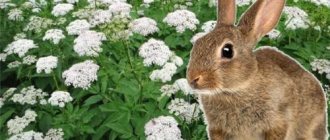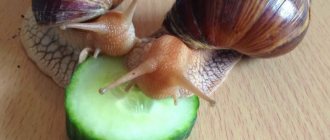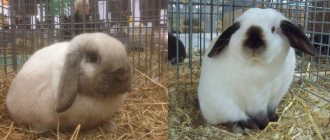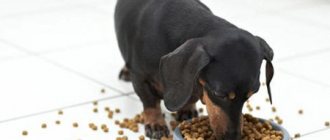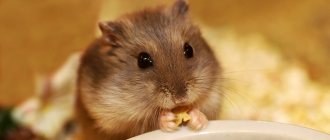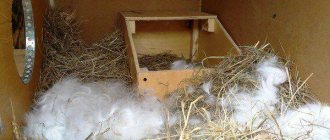- home
- Rabbits
- Feeding
08.06.2018
Feeding decorative rabbits is an important topic that needs to be carefully studied if you decide to get this furry animal. After all, improper nutrition can negatively affect the health of the eared cat.
How does digestion work in decorative rabbits?
Herbivores have a stomach with one chamber.
The food in it is treated with saliva, stomach acids, and then mixed. The site of primary digestion is the cecum in the large intestine. There, under the influence of microorganisms, fiber is broken down. The intestinal muscles of this breed are weak. The animal is not capable of pushing out digested food on its own. For this to happen, you need to get a new portion of food. Long breaks will cause disturbances - food will stop moving. Its stagnation will cause fermentation. Another prerequisite for proper digestion is the constant availability of clean water.
Why is a proper diet important for pets?
Active growth and weight gain are undoubtedly directly influenced by rabbit food, optimally balanced and properly prepared at home. It also allows you to minimize financial costs.
Fulfillment of all conditions allows us to ensure that an adult rabbit can produce at least 30 rabbits per year. With proper nutrition, young animals reach marketable weight (3.5-4.5 kg) at the age of 4-5 months.
If the diet is prepared correctly, the female becomes capable of the next conception within 3-5 days after the birth of the cubs. To summarize what has been said, it should be said that rabbits need to be constantly fed, fed, and fed again.
Diseases due to malnutrition
In winter, rabbits are exposed to harsher conditions, so their health is exposed to additional risks. Weak digestion and switching to harder food can provoke dangerous diseases.
It is important to monitor the animal's appetite. It depends not only on the quality and quantity of food
Rabbits, whether by wanting to eat or refusing to eat, react to many changes in their lives. It is important to constantly monitor any changes in your rabbits' appetite. They can be a timely warning.
Reasons for rabbits refusing food:
- unsuitability of feed for consumption;
- sudden change in diet;
- animal disease;
- unfavorable conditions in the cage - dirt, stuffiness, drafts;
- a new, unusual habitat after transplantation.
Violation of the diet and insufficient quality of nutrition lead to weakening of the rabbit’s body. Weak immunity cannot withstand harsh winter conditions. As a result, rabbits catch colds and develop conjunctivitis.
A common problem when keeping rabbits in winter is indigestion. A weak stomach and intestines are highly sensitive to any changes.
Poor quality food, sudden changes in diet, feeding unhealthy foods, neglect of hygiene products - all this can cause bloating, diarrhea or upset.
Stomach problems in rabbits are difficult to resolve. In winter, digestive difficulties also weaken the immune system, which increases the likelihood of developing colds, viral or infectious diseases.
The quality of food in winter is of utmost importance. This component should be given great importance.
Special treats for grinding teeth
In nature, rodents consume a lot of roughage: branches, dry stems of coarse grasses. Their teeth wear down naturally. When feeding a dwarf rabbit with compound feed, the animal's teeth may not experience the proper load. This leads to overgrowth of teeth, which is why the animal cannot consume food normally.
They buy special sticks for the pet, which rabbits gnaw with great eagerness. You can cut branches of willow, apple, currant, pear, oak, hazel, and aspen yourself. The chocks are placed in the cage along with the bark; they should be 1–3 cm thick.
Norms and feeding regimes
Adult rabbits need to be fed at least 2 times, and even better 3 times a day. But the younger the livestock, the more often they should receive food. The maximum number of feedings is 4 times a day; more often only weanlings are given food. It’s easier to feed rabbits not by hand, but to put up special bunker feeders and hay barns, pour food into them, and the animals themselves will take from them how much and when they need it.
Rabbits can eat often, almost constantly, but better results can be achieved if they are fed according to a schedule. For example, experienced rabbit breeders use such schemes.
| Winter 3 times feeding: | Winter 4 times feeding: |
| 8 hours – half the daily volume of concentrates and hay; 12 hours – succulent food; 17:00 – second half of hay, branches and grain. | 6 hours – a third of grain and a quarter of hay; 11 hours – a third of concentrates and half of juicy ones; 16 hours - half of the hay, vegetables and root vegetables; 19 hours - a third of grain and a quarter of hay + branches. |
| Summer 3 times feeding: | Summer 4 times feeding: |
| 6 hours – half concentrates and a third herbs; 15 hours – a third of the volume of greens; 19 hours – half concentrates, one third greens + branches. | 6 hours – a third of concentrates and 1/6 of greens; 11 o'clock - the same; 16 hours – half the norm of grass; 19 hours – a third of concentrates, 1/6 herbs + branches. |
During the rest period
At about 1 month, babies begin to feed on their own. At this time, they are gradually transferred to the food that the rest of the livestock eats. Month-old rabbits are fed fresh but dried grass, crushed grain, bran, grated vegetables, potatoes, and root vegetables.
As the young animals grow, the norms for all feeds increase. Animals destined for meat are housed separately and fed according to a special scheme. Salt and chalk are given to all rabbits, starting from 5-7 months, the same - 1-1.5 g all year round. Until this age, the norm is 2 times less.
During the period of preparation for mating
Breeding animals are also fed grass, tops, weeds, grain mixtures in summer and winter, root vegetables, kitchen waste, fruits and vegetables. Nutrition during this period (2-4 weeks before mating) should be organized so that the rabbits are moderately well-fed, but not obese.
The food must certainly contain complete proteins and minerals, so legumes, grains and grass, fish meal and meat and bone meal are certainly included in the menu of future parents.
Baby rabbits
Pregnant females need an increased amount of nutrients for the development of their rabbits, especially in the last third of pregnancy. Their food should contain easily digestible and good-quality food, the share of which is increased by 20% compared to the menu of the rest of the livestock.
During the period of suction
The need of the female feeding the offspring for nutrients increases even more, therefore, the older the rabbits become, the more food she should be given. 2 days before and after birth, the animal is fed hay and given water, then transferred to a regular diet.
It must contain succulent food, grass with a high content of protein and minerals, dairy products, potatoes, vegetables, fruits, dill, and a lot of water. A rabbit weighing 3-5 kg requires 19.5-32.5 g of protein and 90-150 starch units. Rabbits that are with the female will try the same things that she eats, so there is no need to specially feed them with anything.
Factory and natural food
Ideally, a pet's diet should contain only natural products. Rabbits living in the wild eat bark, roots, herbs, hay, and some vegetables.
Breeders creating new ornamental breeds of animals do not set themselves the task of breeding animals that can only be fed with canned food or dry concentrates.
Concentrated food, saturated with synthetic vitamins and treated with substances that increase shelf life, can only be used in certain situations for a limited time: when transporting pets to another place of residence, moving.
When regularly feeding animals, when choosing between fresh herbs and mixed feed, it is better to give preference to the former.
Granulated food for rabbits has some features:
- The structure of granules differs from whole hay, vegetables and grass - the structure of the product is unnatural and is less easily absorbed by the rabbit’s body
- Pelleted foods contain less plant fiber, which is necessary for proper digestion.
- By eating more pelleted feed than necessary, animals overeat
- Granular mixtures contain many mineral impurities, which is why kidney stones can form by the second year of an animal’s life.
- Granular feeds consisting of compressed small pieces are not suitable for grinding down incisors: animals simply swallow them
- In the animal’s stomach, dry granules swell, increasing in size several times, which can cause stretching and damage to the gastric mucosa.
Granulated rabbit food should contain the following components:
- plant fibers - 20-25%;
- proteins - 13-15%;
- fats - about 2%.
This food is made from barley grain, corn, oats, alfalfa, legumes, and meadow hay. You can also add vegetables, sunflower cake, bone meal, salt, and chalk to the food. Sometimes vitamins are used as an additive to ready-made granulated rabbit food, the amount of which should not exceed 1%.
The composition of the granule can be determined by its color:
- a light color with a beige, gray or yellow tint means that the composition is dominated by grains;
- bright green color characteristic of grass pellets;
- The presence of vegetables in the granules is indicated by a darker and more saturated shade of green.
The finished food should consist of granules of the same color, which guarantees the stability of their composition. The different pellets in the bag were most likely made in separate batches and then mixed together. The quality of this food is low.
The structure of the granules should be dense and not disintegrate in the hands. Some of them, when transporting large quantities, still crumble, forming grains in the bag, which rabbits eat reluctantly. The quality of granulated feed is higher, the less such grains it contains.
The feed should not contain growth stimulants or dyes. The exact vitamin composition must be indicated on the packaging.
Choosing granular food for rabbits
If you have to feed a decorative rabbit with granulated food for a short time, you need to choose a quality product. The composition of granulated food includes vegetable proteins, carbohydrates, fiber, vitamins, mineral supplements, and raw ash. Pelleted food should be given to animals strictly according to the standards indicated on the packaging.
After feeding rabbits with granulated food for a long time, you need to gradually transfer the animals to natural nutrition. Vegetables and hay should be gradually included in the animal's menu over 7-12 days, reducing the amount of dry concentrated feed. If an animal feels unwell due to a change in diet, it should be taken to an experienced veterinarian.
What can you feed eared animals?
The peculiarity of the digestion of these animals is that their stomach, which has weak muscles, must constantly be filled with food and enough water so that the food moves further into the small intestine, where food is broken down into sugars and amino acids, and then into the large intestine, where excess moisture from food passes into the animal's body.
This explains the frequent feeding of rabbits - eared rabbits have up to 60 meals in small portions per day. Accordingly, you need to ensure that there is always clean water and food in the cages (at least, the nursery should always be filled with hay).
It is necessary to ensure that there is always clean water and food in the cages
Another feature of the rabbit body is coprophagia. Don’t be alarmed by the fact that animals sometimes eat their waste: in this way they supply their bodies with vitamin B. The fact is that in the cecum of animals, intensive processing of grass and hay occurs under the influence of bacteria, as a result, nutrients vital for the eared animals are released out with droppings (at night). If you deprive a rodent of the opportunity to eat litter at night, they will begin to lag behind in development, and if you overfeed your pets, they will stop eating litter, which will also negatively affect their health.
In the warm season, the best food for rabbits is tree shoots, leaves, and grasses. Green food is not only good for your pets, but also can significantly reduce the cost of feeding them. It is recommended to give animals wild herbs: nettle, clover, plantain, wormwood, yarrow, wheatgrass, shepherd's purse, rapeseed, fireweed, burdock, meadowsweet, horse sorrel
Introduce legumes into your diet carefully, in small portions, to avoid intestinal problems. Little by little you can feed beet tops, carrots, rhubarb, cabbage leaves
Feeding rabbits at home is not complete without hay and branches of various trees.
Focus on what rabbits like, but don't follow their lead. So, little eared animals will happily eat only dandelions or rapeseed, but there is little benefit from such food. It is not recommended to feed animals the same type of grass every day because they begin to lag in growth and their health may deteriorate. Alternate different herbs or feed them to your pets in the form of different herbal mixtures.
Feeding rabbits at home is not complete without hay and branches of various trees (aspen, willow, ash, linden, apple, pear, hazel). Eared cats especially like soft, well-leafed hay, with which they receive the necessary vitamins and minerals.
What do long-eared animals eat, besides grass and hay:
- succulent foods, including zucchini, pumpkin, potatoes, beets, carrots, melon rinds, pumpkins, watermelons;
- cereal grains (oats, corn, barley, wheat) and legumes (peas, beans, soybeans, lentils), flax seeds;
- cake, meal, bran and feed;
- fish, meat and meat and bone meal.
When learning how to properly feed rabbits, pay special attention to dangerous foods that you should avoid.
Any compound feed can be used, with the exception of poultry feed. Feeding with compound feed is beneficial because animals receive from it a large amount of complete protein and important minerals.
When learning how to feed rabbits properly, pay special attention to the following, which should be avoided or given in very small quantities. Don’t succumb to the charm of little fluffies and don’t pamper them with sweets - simple carbohydrates are very harmful to the health of the eared ones!
Nutrition of decorative breeds
If rabbits are bred not for meat, but for beauty, the feeding process changes somewhat. The diet itself remains approximately the same. It should also include fresh and dried grass, various gifts from vegetable gardens and orchards, animal feed, mineral and vitamin supplements. But you can’t just build a bunker feeder for your pet. He will become fat and will not live long.
Decorative rabbits require a special approach
It is important to maintain a balance between constant chewing and daily nutrient requirements, as well as to control your pet’s body weight. To ensure a natural feeding regime, it is worth purchasing feeder toys for your fluffy, which make it difficult for the animal to access food and force the animal to get it:
To ensure a natural feeding regime, it is worth purchasing feeder toys for your fluffy, which make it difficult for the animal to access food and force the animal to get it:
- balls made of metal wire for grass and pieces of vegetables (hanging and rolling on the floor);
- plastic balls for granulated food;
- “hedgehogs” made from twigs.
The advantage of such feeders is that the rabbit will be busy most of the day, and he will not have time for mischief.
How to prepare food for the winter
Hay is an essential product for pets. A decorative rabbit requires from 12 to 17 kilograms of dry grass per year. Several bags of hay can be bought inexpensively from farmers and owners of private farmsteads in villages. If the owner of the animals lives in a rural area or spends the summer at the dacha, then he can prepare this product himself.
Hay can be bought from farmers
Harvesting hay
When making hay, you need to remember not to mow grass near permanently operating roads. Plants absorb and accumulate compounds containing lead, which is present in car exhaust gases. Diesel engine emissions contain benzopyrene and other harmful compounds. Mowing should be done no closer than 30-40 meters from the road.
Cut hay
Grass growing along railways may contain a variety of substances that are not at all beneficial for rabbits. A variety of bulk and liquid cargoes are transported on railway platforms, including coal, mineral fertilizers, fuels and lubricants, and industrial chemicals. Therefore, you should not mow grass for food next to the railroad bed.
Do not cut grass near railroad tracks
It is also prohibited to harvest hay in protected zones of industrial enterprises. Gaseous exhausts, smoke, and dust are deposited on the grass, making it unsuitable for animal nutrition. The ideal place for mowing is a meadow, open steppe, field, forest clearing, river banks far from cities.
- The grass is mowed with a scythe or an industrial mower; if the area is small, you can use a lawn mower or sickle.
- The cut grass is left to dry (the material must be turned over to dry completely).
- The hay is piled up, stacked or taken out for storage.
Mowing grass
Preparation of branch forage
Branch food is made from branches of wild and fruit trees and their undergrowth. You can prepare fodder brooms from shoots and branches:
- poplars;
- aspen;
- ash;
- and you;
- elm;
- apple trees;
- ranetki and other trees.
Branch food
Harvesting of branches begins when the leaves reach their maximum size and the leaf petiole is well attached to the trunk - at the end of June or at the beginning of July. Branches up to one centimeter thick are cut from the tree. The length of the branches is up to one meter (willow twigs are longer - up to two meters).
The branches are tied into bundles and hung to dry. Brooms should be dried out of direct sunlight. When dried in this way, the leaves remain green, and the bark and branches remain fragrant.
Coniferous tree branches can be harvested all year round. During drying, the needles break off and fall off, so it is better to give coniferous branch food fresh. Fresh pine needles contain a lot of vitamin C, bactericidal substances and are very useful for lagomorphs.
Coniferous tree branches can be harvested all year round
Profitability of raising rabbits for meat
First you need to determine for what purpose you are getting rabbits. If you are just starting to breed them, then it is more profitable to take well-known local breeds.
The profitability of raising rabbits is determined by several factors (Figure 6):
You need to purchase healthy, active individuals, with a well-fed, well-built body, clean eyes and shiny fur. Animals with elongated heads, floppy ears, sagging backs and bellies, and balding hair are considered unsuitable. You need to take care of the housing for the livestock in advance. For outdoor keeping, cages with two compartments are equipped. Feeders and drinkers are fixed inside. Indoors in winter, cages with double ceilings and thick walls are insulated. Cages can be made of different materials, but there should be no drafts in them
It is important to ensure a constant flow of fresh air and optimal daylight. The cells are arranged in several tiers with a passage between them and moderate lighting. When raising rabbits for meat, the light intensity is reduced for the fattening period.
Then choose a maintenance method that will suit your conditions. If there is not enough space on the site, but there is a basement or cellar, then you can keep animals using the pit method.
Rabbit meat is a quickly digestible, high-quality product containing a lot of protein. It is recommended for children, athletes, women during pregnancy and lactation.
Figure 6. Calculation of the profitability of rabbit breeding
When raising rabbits for meat, profit will be brought by meat breeds with rapid growth, weight gain, good quality products, as well as representatives of the meat-skin direction of productivity.
All carcasses must comply with approved GOSTs and quality standards. After slaughter, carcasses are cleaned of all internal organs except kidneys. The head is separated at the first cervical vertebra, the hind limbs at the hock joint, and the forelimbs at the carpal joint (Figure 7).
Rabbit carcasses are usually divided as follows:
- Cooled - temperature no more than 25 degrees;
- Chilled - from 0 to 4 degrees;
- Ice cream - no more than 8 degrees below zero.
To sell rabbit meat, it must be frozen or refrigerated. It is not allowed to sell carcasses to retail chains if they have the following defects:
- Bone fractures;
- Back fat takes up more than a third of the total length of the carcass;
- Cleaning up bruises or bruises;
- Carcasses that were frozen more than once, after which the color changed (became flesh-colored).
During marking, each carcass is marked with a mark on the outer side of the drumstick: carcasses of the first category are given a round mark, carcasses of the second category are given a square mark, and broiler carcasses have an oval mark. If the carcass does not meet the requirements, a triangular mark is placed on the back. From the video you will learn basic recommendations for fattening rabbits for further sale for meat.
Business plan "rabbit farm"
To benefit from rabbit breeding, a business plan is drawn up that considers the main aspects of rabbit farming. A farmer needs to become an individual entrepreneur, since this form of ownership reduces taxes and makes accounting easier.
Figure 7. Cutting a rabbit carcass
The profitability of raising rabbits for meat is average, since this product is not considered the most popular on the market. Fattening animals for meat as a business includes several preparatory stages.
First of all, you need to select a plot of land. A profitable option would be a plot with a minimum rent. The next step is purchasing cells. By building them yourself, you can save your money. At the third stage, you should purchase rabbits. And also hire an employee who will take care of the animals.
The organization of sales must be thought out before starting the organization of the economy. Clients can be meat markets, supermarkets, and individuals. The skins can be sold to fur studios and private fashion designers.
Essential Vitamins and Minerals
As a rule, a lack of vitamins and minerals is observed in rabbits in winter and early spring. There are several vitamin and mineral complexes that are very successfully used by rabbit breeders:
- "Chiktonik" - includes about three dozen vitamins and basic amino acids. The drug is given in five-day courses, every month, at the rate of 1 ml per liter of clean water;
- “Prodevit” is a vitamin complex designed for weakened animals suffering from ulcers, rickets, liver diseases, and pathology of the mucous membranes. The drug is available in injection and oral form;
- “E-Selenium” is a drug intended for the correction of developmental and growth disorders, exacerbation of infectious diseases, treatment of poisoning and other pathologies. Available in injection and oral form.
Mineral supplements represented by mineral stones: “Chika” and Karli have proven themselves very well. You can also use "Bio-iron", supplemented with essential microelements, and the vitamin and mineral supplement "Ushastik".
Use of vitamin and mineral supplements
Vitamin preparations are usually administered in late winter, when there are not enough natural vitamins in the feed. They can be bought at a veterinary pharmacy; the range of products is quite wide, for example, the following are popular:
- Chiktonik;
- E-Selenium;
- Prodevit et al.
Depending on the method of administration, drugs are administered by injection, vitamins are added to water or simply to food.
They give their pets fish oil, as well as oil solutions of tocopherols and calciferols, and retinol. To replenish the body of rabbits with vitamins, especially compounds from group B, they are given baker's and brewer's yeast; to replenish vitamins and animal protein - fish meal and meat and bone meal (5-10 g per individual). Tricalcium phosphate is also used, from which rabbits obtain calcium and phosphorus.
Fish oil is given to rabbits in the following volumes (per individual):
- rabbits - 0.3-0.5 g;
- for adult livestock – 1 g;
- for female rabbits during pregnancy and feeding – 3 g.
Regular salt is given in a volume of 0.5-1 g per 1 head (young animals) and 1-1.5 g per 1 adult.
Water in the diet of rabbits
Rabbits must have water in their diet. If it is deficient, animals will have a decreased appetite, poor digestion of food, and a deterioration in their overall condition. It is especially important to provide constantly filled water for pregnant and lactating rabbits. When feeding, they lose most of the liquid with milk. Growing rabbits also need water.
The amount of water for rabbits will depend on the time of year and the food being fed. In summer, rabbits receive a lot of green and succulent food, so the need for water is not so high. However, given the hot weather, they still need to drink water. During the winter season, rabbits receive mostly dry food and need to drink more. If the water freezes quickly in the cold, then you need to pour it into drinking bowls immediately after eating concentrates. You can pour warm water.
It is necessary to water the rabbits, providing them with water constantly. In the absence of water, female rabbits can eat their offspring.
Features of digestion of decorative rabbits
Food entering the rabbit's mouth is moistened with saliva from the salivary glands and chewed with the help of sharp teeth that are constantly growing. Next, the chewed lump of food is sent through the pharynx through the esophagus into the stomach.
The intestines of rabbits are small in size and have two sections - thin and thick. At the junction of the small intestine with the large intestine there is a “blind” reservoir, from which substances that suppress the development of colic and alkaline juice are released, which breaks down fiber and enhances the fermentation of food
Rabbit intestines have weak peristalsis, so it is important to monitor their diet and avoid food stagnation. Despite weak peristalsis, long-eared digestion is accelerated, so the animals eat constantly
Considering the characteristics of the rabbit digestive tract, a number of conditions must be observed:
- do not let your eared starve;
- create a varied diet;
- give your pet solid food for cutting down teeth;
- To prevent constipation and loss of fluid in the body, animals should always have a drinking bowl with clean water.
What should you not give to rabbits?
Decorative rabbits cannot be fed with food from the owner's table. Errors in nutrition can cost a pet's life. It is prohibited to feed your pets the following foods:
Meat should not be given to rabbits
- meat;
- sausage;
- confectionery - sweets, baked goods;
- fresh bread;
- dairy products;
- poisonous plants;
- rotten hay;
- rotten vegetables;
- wet grass.
By following the rules of feeding a decorative rabbit, you can be calm about its health. By receiving adequate nutrition, the animals’ immune system will become stronger, and the intestines will function correctly, without failures.
Preparing a diet for baby rabbits
The nutritional rules for newly hatched rabbits can be divided into stages depending on age:
- After birth, rabbits feed on their mother's milk for 2-3 weeks.
- Then you can add hay and specialized feed.
- After a couple of weeks, feed portions are increased. Monitor the animal's reaction.
- Two months after birth, the rabbits do not need mother's milk; the diet remains hay and dry food.
- After 3 months, you can offer your rabbits vegetables. They need to be introduced gradually and watch how the pet reacts. Increase portions over time.
- After 7 months it is allowed to eat hay in large quantities. It needs to be within the rabbit's access area, as well as drinking water. You can introduce grain feed and increase the amount of juicy food.
It is better not to overfeed your rabbit until it is six months old to avoid excess weight. Pets move little and sleep much more than animals living in captivity. Therefore, it is not by chance that they are at risk of obesity.
Diet of adults
Rabbits love sweets, the consumption of which should be avoided in large quantities. There are special candies or tablets that supposedly contain beneficial substances. In fact, they contain too much sugar, which is harmful to pets. They quickly get used to them and refuse to eat. It is better to offer your rabbit vegetables and fruits as treats, but also in small quantities.
It is better not to use products containing vitamins used to feed animals. Nutrients are found in a properly planned diet. The main thing is to diversify it, combining solid, juicy and grain foods. Dwarf rabbits become satiated quickly, so they need food constantly. It must be remembered that hay is allowed to be consumed in unlimited quantities. It does not contain many calories, improves digestion and helps grind teeth.
General nutrition information
Dwarf rabbits eat the same as their larger counterparts. Animals are strict vegans, that is, they eat only plant foods. In nature, they eat herbs and seeds, roots and twigs of shrubs, and fallen leaves. They do not disdain fruits, berries, and some root vegetables that have fallen from trees.
A rodent's teeth and entire digestive system are designed to process rough, fibrous plant foods. A lack of fiber in an animal's diet, if the emphasis is on concentrates, can lead to constipation and other health problems.
What grass do rabbits eat?
As you know, rabbits love to eat fresh and juicy grass. At the same time, they get not only pleasure from eating it, but also great benefits, since green food contains a large amount of vitamins and microelements, which are an integral part for proper growth and development. In addition, this type of feed is quite profitable, since it does not require any special expenses, because you can mow as much grass as you like. It is worth considering what exactly should be given to rabbits as green food.
An excellent solution would be freshly cut meadow grass and tops from your garden. Suitable meadow plants include alfalfa, clover, burdock, coltsfoot, quinoa, sorrel, tansy, fireweed, heather, and sage. It would also be good to give plantain and dandelion, since they contain carbohydrates and proteins in sufficient quantities. Due to their bitterness, wormwood and chicory should not be introduced into the diet of females who are feeding milk. But for ordinary adults, this will be an excellent remedy for the prevention of digestive tract disorders, which can also increase appetite
Nettle is overly enriched with proteins and vitamins, but it is important to give it correctly. First you need to wilt the leaves a little, then pour boiling water over them, only then add them to food (you can mix it with potatoes)
But when collecting meadow grasses, you need to be very careful not to pick up plants that rabbits absolutely cannot eat. These include: dope, belladonna, ranunculus, celandine, lilies of the valley, hemlock, henbane. During the drying process, the toxicity of the listed herbs disappears, but they should not be given in freshly collected form under any circumstances. Tops from various vegetables from the garden, for example, rutabaga, sugar beets, turnips, carrots, and Jerusalem artichokes, are also suitable as a juicy treat. You should not give tomato tops. Rabbits like legumes and cereals, but it is better not to give them in their pure form, so as not to cause flatulence, but to mix them with other types of food.
Despite all the abundance and availability of this type of food, it is worth remembering that any grass (even the most healthy) cannot be given freshly cut, but needs to be dried a little. In addition, one should not forget about all the other nuances associated with the supply of this type of food, then the functioning of the digestive tract of your pets will be completely adjusted.
Main types of feed
Experienced breeders will be able to easily answer the question - what to feed rabbits? However, for beginning farmers, not everything is so simple. Animals' menus should include a variety of vegetables, herbs, grains and mixed feed.
All food can be divided into several types:
- green;
- rude;
- juicy;
- concentrated.
Each type of feed has its own characteristics and requires proper feeding. While some foods can be given raw, others can only be given boiled.
Green food for rabbits
As soon as the first shoots of plants appear in the spring, rabbits can be given green food.
They must be present in the animal’s diet and include:
- Wild herbs. Please note that not all of them are suitable for feeding rabbits. It is best to harvest them in natural meadows. If possible, you can grow the necessary herbs on your site. Suitable for this purpose: lupine, clover, alfalfa, oats, barley, corn.
- Vegetable tops and cabbage. The tops of rutabaga, Jerusalem artichoke, potatoes, fodder or sugar beets, and turnips are suitable as such green food. If you choose beet tops, you should feed them no more than a third of the total amount of green feed. It has a laxative effect. Along with it, oak leaves and branches, which have fixing properties, should be added to the feed. Alder, comfrey or yarrow are also suitable.
- Seeded legumes and grain grasses. They are beneficial for rabbits due to their high protein and vitamin content. However, feeding them alone will lead to bloating, so they need to be combined with other types of food.
Despite the fact that potato tops are allowed for rabbits, they should be given with caution. To do this, it should be mowed 4–5 days before the planned harvest. Introduce it into the food gradually, adding a little at a time.
Rough feed for rabbits
When choosing what to feed your rabbits, do not forget about roughage. These include: hay, straw, branches of some trees. They help improve the digestion of rabbits and additionally grind down teeth, which is also necessary for furry animals. They will happily gnaw the bark from the branches and will not damage the cage.
Young branches of raspberry, acacia, linden, willow, apple and aspen are best suited. This is a favorite treat for rabbits.
It is worth highlighting hay as the main element among roughage. It must be harvested from the same types of green plants that rabbits eat in the summer. It should be mowed before the grass begins to bloom. After this, it must be left in the sun to dry thoroughly for several days. Even dry hay still needs to be dried under a canopy so that it does not rot later. It should be stored indoors on wooden floors.
If the weather is rainy for a long time during the hay harvesting period, then you need to mow it in small areas. After this, it should be laid out in thin layers on shelves made of metal mesh or on wooden slats. Don’t delay cutting hay for feed. If the grass gets too rough or sits in the rain for a long time, rabbits will have trouble eating the hay. If you manage to prepare hay only in rough form, then it is better to grind it into flour. When receiving it along with other food, animals will eat it with pleasure.
For one adult rabbit you need to prepare about 45 kg of hay. This amount should be enough for the winter. If you plan to have offspring, then you should stock up on hay for the babies. 10–15 kg per baby rabbit will be enough. If there is not enough hay for the winter, then first of all it should be given to lactating females.
Branches, like hay, can be stored for the winter. They will be a good source of vitamins during the cold season. To harvest them, branches from suitable trees should be well dried. It is most convenient to do this under the roof of a shed, where good ventilation of such roughage will be ensured. In addition, in winter you can feed your pets with fresh spruce or pine branches. They will help increase appetite and have a beneficial effect on the coat. The only thing is that you need to give them in small quantities and take breaks.
What succulent food can you feed rabbits?
If at the beginning of summer most of the rabbits' diet consists of green food, then later the grass begins to turn yellow and there is not enough of it. During this time, you can give your rabbits a variety of root vegetables. Melon crops are well suited. They will love pumpkins, zucchini and watermelon. These foods are rich in vitamins. The only thing is that they are low in protein and fiber, so they need to be given in combination with other foods.
A nursing rabbit needs more vitamins than a normal rabbit, so she needs to eat root vegetables. In addition, succulent foods help increase milk supply.
It is important to know the best way to feed certain foods. It is better to give carrots to rabbits in a raw state, after washing them well from the soil. You can put it in cages whole or cut into pieces. Rabbits will happily chew on it. Cabbage can be given either fresh, boiled or pickled. However, to prevent digestive disorders, introduce it into the diet gradually and little by little. Zucchini can be given raw. They promote better absorption of other feeds. Pumpkin is given both raw and boiled. Small rabbits can make puree from it. It also helps increase growth and promotes greater milk production in nursing rabbits.
Silage is of great importance in feeding succulent feed. It is prepared from grass, tops, vegetables and melons. The more ingredients there are, the more nutritious and healthy the food will be. Silage, which contains a mixture of beets, tops, cabbage and carrots, is well digested by rabbits.
To prepare silage, you need to chop all the ingredients into small pieces and then compact them thoroughly. It is advisable to do this in large pits with a wooden frame on all sides. You can also use a wooden barrel for this. By placing the crushed ingredients in the pit, it is necessary to limit the supply of oxygen. To do this, cover everything with film and then sprinkle it with a layer of earth and straw. Such food will be ready only after 1.5–2 months.
Concentrated feed for rabbits
Despite the beneficial properties and nutritional value of green and juicy food, rabbits must also be given concentrated feed. These include:
- cereals;
- bran, cake, meal;
- legume grains;
- compound feed;
- animal feed.
Due to the high protein content and small amount of water, concentrated formulations have a high energy value. They help rabbits grow faster and more intensely. In nursing rabbits, they help increase milk production.
Oats, corn, rye, barley, wheat, peas, beans, and lentils are good choices for cereals and grains. It is desirable that 30-40% of the daily diet consist of concentrated feed. It is also important to know how to properly give such food to rabbits. Thus, oats can be fed to animals in the form of whole grains, crushed or flattened. It contains many nutrients, but is considered a dietary food. You can often feed grain to rabbits without fear of their obesity. It will have a good effect on intestinal motility.
It is better to give corn to rabbits soaked or crushed. In addition, you can cook porridge from it, which the animals will also like. This product is especially useful for fattening rabbits. It can be combined with legumes, which contain a lot of proteins and amino acids.
Wheat, barley, sorghum and rye should be given in crushed form and better mixed with other types of feed. There is no need to give them in large quantities. This may lead to bloating.
You should not neglect feed. It has a balanced composition that allows you to satisfy all nutritional needs. There is a special concentrate for rabbits, which is made in the form of small and large granules. With its help you can replace all other types of concentrated feed. However, this will be a more expensive meal, which will hit your pocket. It will also help raise animals faster.
When choosing feed, you need to take into account the age of the rabbits. There are mixtures intended for young individuals from 1 to 3 months, and there are also up to 6 months. Larger rabbits can be given any type of food.


